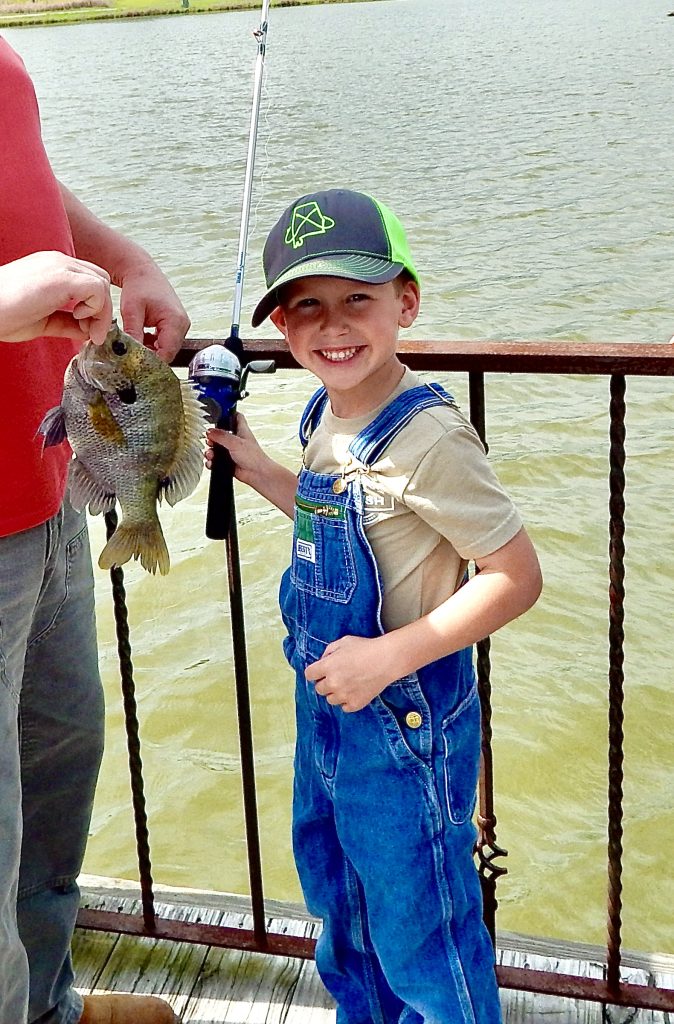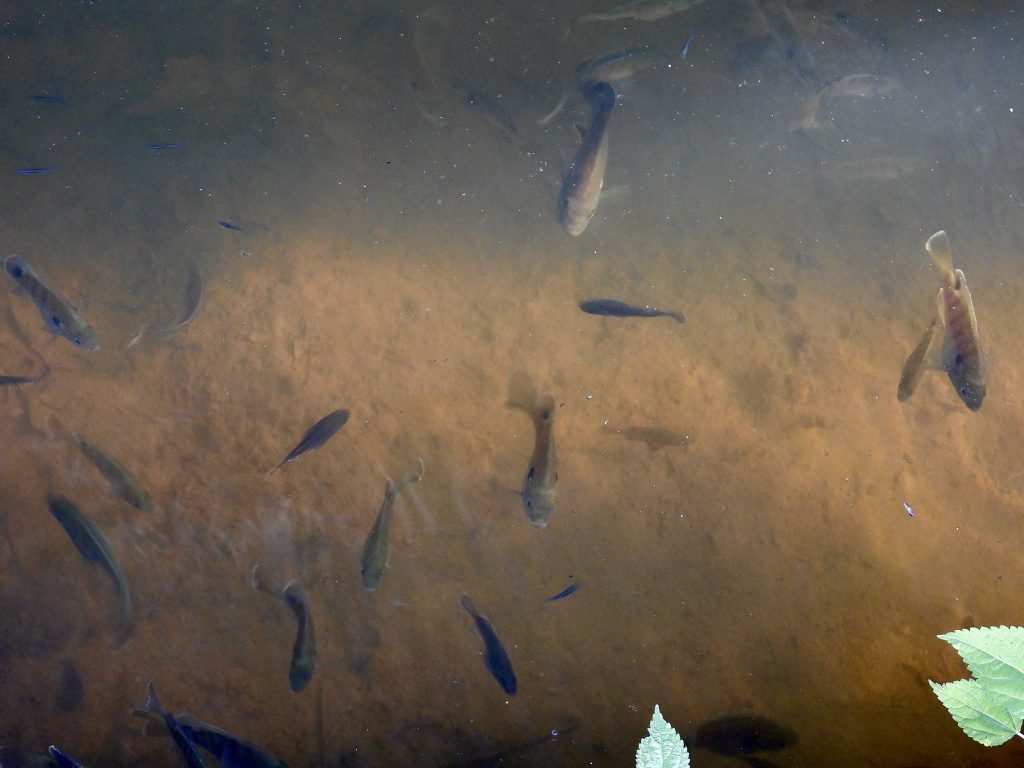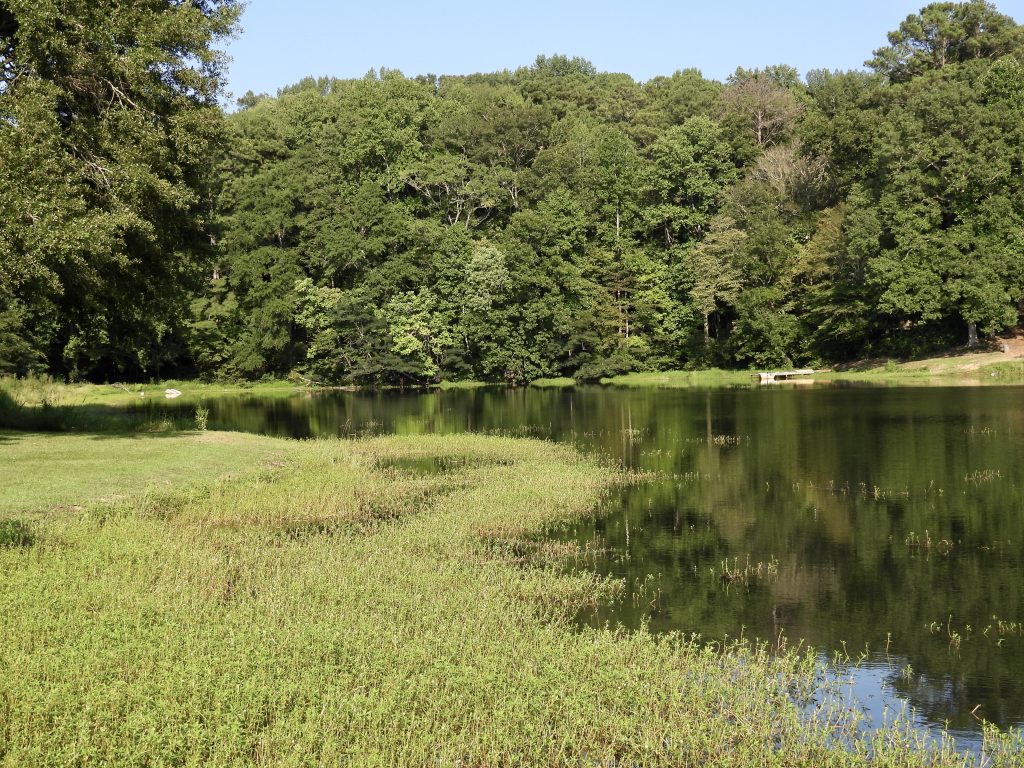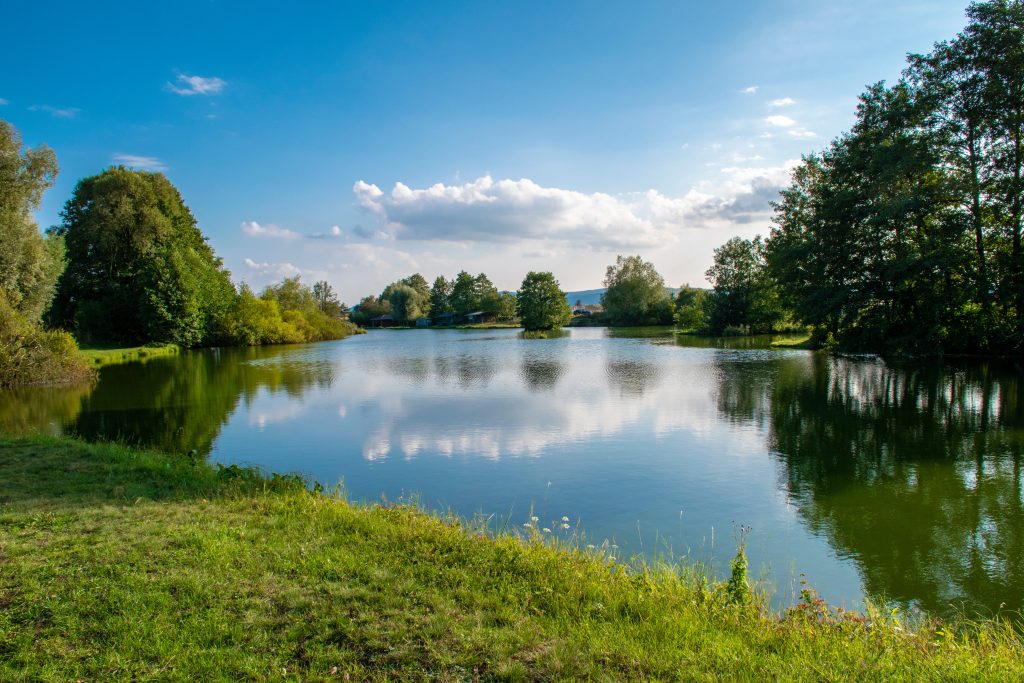Alabama has over 250,000 ponds & lakes smaller than 100 acres, located on farms, rural properties, and urban areas. Ponds have introduced generations of children to the joy and mysteries of angling, and that alone is a great reason to build and maintain one. This article will focus on how to evaluate an existing pond and help determine the right mix of fish for your pond stocking situation. It will also discuss how to maximize their growth and your enjoyment as you provide a small oasis for the wildlife that will call your pond home.
We discussed this topic with Chris Greene, the Fisheries Section Chief in the Wildlife and Freshwater Fisheries Division at Alabama’s Department of Conservation and Natural Resources. Chris and his colleagues have six decades of research from which they can offer advice and provide answers to pond owners.
We also sat down with Norman Latona. Norm is the president of Southeastern Pond Management, which offers services that cover the waterfront of pond development and management. SE Pond provides ecosystem analysis, management programs, pond construction, liming, fertilizing, fish inventory assessment, removal processes, stocking of forage and game fish, maintenance and more throughout the southeast.
Assessing Stock Pond Conditions
According to Latona, whether the pond is going to be managed for trophy largemouth bass, big “slab” bluegill or to be a balanced fishing lake with no emphasis on growing exceptionally large fish, it absolutely has to be fish free.
“When you are restocking or stocking fish for the first time it is critical that the water we are stocking is free of fish,” Latona said. “We need to prepare it properly and make sure that there is nothing that will compete with what we are going to introduce and interfere with that dynamic.”
To that end for existing ponds, SEPond will come in and use a fish toxicant that will eradicate the existing fish population and, in a short period of time, the toxicant will dissipate and leave a pond that is ready to stock. This killing of fish is necessary because the last thing a pond owner wants is to introduce fingerling fish stock that will be easy prey for undesirable species.
Understanding a pond’s overall condition is imperative before adding fish. Identifying any aquatic weed issues, determining its exact size, depth, water quality, and alkalinity, along with surveying the nearby watershed, is a good starting point. Establishing your short-term and five-year goals will affect the type of fish you choose and the stocking rate.
A GPS, pond calculator app, or Google Earth can help calculate precise surface estimates and water volume. Mark a rope in one-foot increments and use a weight to measure water depth. Take measurements along the length and width, then average your findings. Multiplying surface area in acres by the average pond depth in feet will produce the number of acre-feet of water. One acre-foot of water is equal to 325,851 gallons.
Precise numbers will better equip owners as they begin the evaluation process. Greene recommended calling your local District Fisheries office or a reputable licensed Fisheries Consultant before starting the process.
Choosing The Right Species When Stocking Your Pond
Choosing an appropriate mix of fish is crucial to the success of your pond. They should ideally match your pond’s size and conditions, intended purpose, and location.
Bream- Bluegill are typically stocked first in the Fall or Winter at a rate of 1,000 fish per acre, and Greene recommends that Redear (Shellcracker) should comprise 15% of that number. Some experts recommend Coppernose Bream plus Redear because of their growth rate. Allowing bream to establish their population through bedding before the introduction of bass is critical, and waiting until your bream spawn before adding bass will produce sufficient forage.

Providing feeders for your bream can increase the forage for your bass and accelerate their growth rate.
Fathead Minnows- Experts recommend adding these minnows to the mix at 1,000 per acre to provide bass additional forage, and with careful monitoring, can be added at intervals if needed.
Bass- Traditional pond stocking ratios include 100 bass per surface acre. A largemouth bass actively consumes anything they can chase down, including bream, minnows, shad, crawfish, and insects. In ponds, largemouth bass grow to optimum size and weight when presented with a variety of forage species.
The two main species of largemouth bass are the Northern largemouth bass (Micropterus salmoides salmoides) and the Florida subspecies (Micropterus salmoides floridanus). Northern largemouth are generally easier to catch and often grow to ten pounds or better. The Florida strain can grow to over twenty pounds but are more challenging to hook and are more susceptible to cold weather mortality.
Older bass stocking plans revolved around catching good numbers of fish or growing a trophy. Pond owners wanting to produce trophy bass stocked Florida bass, while those wishing to boat numbers of decent-sized fish chose the Northern variety. Another option involves choosing a combination of Northern, Florida, and the newer F-1, a cross between the Northern and Florida species.
Experiments in aquaculture that began a few decades ago have resulted in a line of fingerlings that can grow two pounds a year and, when properly managed, can achieve weights up to 15 pounds in eight years. These F-1 or Tiger bass hybrids are often the choice of pond owners who want to focus on a fast-growing gamefish with a more aggressive attitude towards lures.
These guidelines are typical, but Greene states that a pond’s water quality and the owner’s goals will dictate the number and type of fish they recommend.
A constant supply of appropriately sized forage must always be available to accelerate and maximize largemouth bass growth. While the management plan for each pond is different, an important constant in stocking from scratch is that the forage fish always go in first and need time to establish themselves and start reproducing.
“The more secure and abundant the food source, the faster the bass are going to grow. When I say forage fish, I’m talking about everything from bluegill to shellcrackers, fathead minnows, golden shiners and even threadfin shad. Typically, the bluegill that we stock are in the one-to-two-inch size range,” Latona said.
Calculating Pond Stocking Rates
A thorough assessment of your watershed, soil, aquatic plants, and water quality, along with your goals, will determine how many and when each species get introduced. Properly evaluating the issues affecting a pond’s water quality will avoid overstocking, which can lead to a food shortage, disease outbreaks, and depleted oxygen levels.
Pond stocking rates refer to the number of fish you can safely introduce to your pond without causing overcrowding. This figure is typically calculated per surface acre and depends on factors like fish species, pond size, and the presence of natural food resources. Consultation with a fishery biologist or a local extension office can provide helpful guidance.
Measuring the perimeter of your water with a handheld GPS, a dedicated pond calculator, or even Google Earth can help you determine a precise measurement of your pond in acres. Knowing your depth and water volume is helpful, but the surface area is the primary factor when calculating stocking rates.

Greene explained that no matter how deep your pond is, the water’s thermocline is consistent in most ponds and lakes. When determining pond stocking rates, the thermocline depth is a primary consideration, not the overall pond depth.
This thermocline occurs in the Spring and Summer as the sun heats the water’s surface. It appears where there is a marked temperature difference between the upper and lower water columns. The warm, wind-mixed waters nearer the surface contain more dissolved oxygen, and bass will spend most of their time above the colder, less oxygenated water.
Sourcing Fish When Pond Stocking
You should purchase fish from reputable hatcheries or suppliers that provide disease-free stock. If possible, choose local suppliers because of the shorter haul, and their fish will be acclimated to similar environmental conditions. A phone call to your local District Fisheries Biologist is a great starting point in locating a reputable source for your fish. Always ask for references.
Hatchery fish will only be available for stocking in certain months, so planning is vital. The Alabama Cooperative Extension has a website with contact information for Fisheries consultants in many Alabama counties and neighboring states.
Stock Pond Maintenance And Management
Maintaining the appropriate alkalinity level in ponds helps to stabilize pH levels, aids in algae growth, and allows fertilizer to be effective. The correct alkalinity level is crucial for fish health, and a minimum reading of 20 ppm up to 40 ppm allows for proper algae growth and can be measured with a simple water test kit.
Readings below 20 ppm call for adding lime. The amount of lime needed to adjust your alkalinity levels requires precise calculations based on the total volume of water in your pond. Applying 4.5 pounds of lime per acre-foot of water will increase the total alkalinity by approximately one ppm. Agricultural limestone is the best choice in recreational fish ponds and should be added in the fall or winter.
Larger ponds may require a small barge to properly distribute the large volume of lime needed to correct the water quality. A higher alkalinity reading is desirable if herbicides are to be used to address aquatic weed issues.
Proper maintenance is critical to ensure the health and growth of your stocked fish. Regularly monitoring water quality, fertilization, supplemental feeding, managing aquatic vegetation, and providing structures for fish habitat are vital for a healthy, sustainable fish population. Scheduled visits from a pond management professional can ensure your pond remains healthy.
Pond Stocking Growth And Harvesting
Growth rates vary among species, water fertility, and available forage. One year after stocking your bass and after they have completed spawning is considered the earliest acceptable time to begin harvest.
At this point, bream should be 1/4 to 1/2lb in adequately managed ponds, and bass should weigh between one and two pounds.
In balanced, fertilized ponds, Greene recommends that bass be harvested at a rate of 25-30 lb per acre and bream at 125-150lb each year. Harvesting should be consistent and evenly spread over 12 months, and for unfertilized ponds, owners should reduce their harvest rate to 1/2 of the recommended weight for fertilized ponds.
Consistent, selective harvesting of your bass and bream will increase the remaining population’s weight and size, and keeping accurate records of your catch can help maintain a healthy environment where your fish can maintain maximum growth rates.
Harvest rates may vary depending on your pond’s stocking rate and species mix. Your District Fisheries Biologist or a local licensed Fisheries Consultant can offer professional advice tailored to your situation and goals.
Common Issues When Pond Stocking
Some common issues encountered during and after pond stocking include overcrowding, disease outbreaks, poor growth rates, weed issues, and predator problems. Proper planning, regular pond maintenance, and sustained fish harvesting can prevent or manage most of these issues.
Cautious use of pesticides and fertilizer on the property surrounding your pond is necessary to avoid water quality issues.
Vegetation- Aquatic plants provide food, oxygen, and shelter for fish but can often grow to become a nuisance and impact water quality. The balance of vegetation is crucial in maintaining a healthy aquatic environment, and professional assistance is often needed when weed issues worsen.

Predators– Humans are not alone when it comes to enjoying a fish dinner. Various airborne and terrestrial predators love fresh fish and left unchecked, can affect your fish population.
Regularly check your dam to look for signs of beaver or otters. Though beavers won’t eat your fish, they can tunnel into your dam, clog your drainpipe, and prematurely harvest nearby timber.
Otters- can weigh up to 30lb and easily consume 10 to 20 pounds of fish each night. These clever nocturnal predators often work together to herd a school of fish into the shallows, where they become easy prey. In recreational ponds, they often target the larger fish and can significantly affect the fish population in smaller lakes.
So, monitor trails across your dam for scat with fish remains and partially eaten fish around the perimeter. Check with your local state game and fish agency for regulations, as permits or licenses may be required to eliminate their thievery. Hiring a professional trapper is often the best option for ridding your pond of these wary predators.
Final Thoughts On Pond Stocking
Pond stocking can transform any puddle of water into a vibrant, self-sustaining ecosystem teeming with life. However, success requires understanding the process, careful planning, and ongoing management. With these elements in place, you can create an aquatic haven that provides enjoyment and value for years to come.




